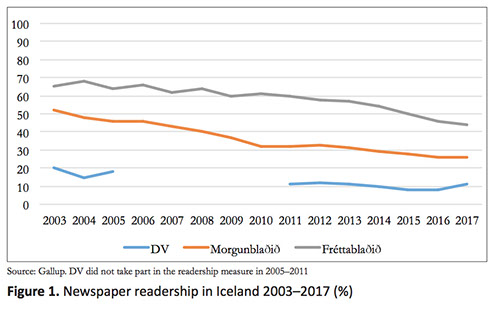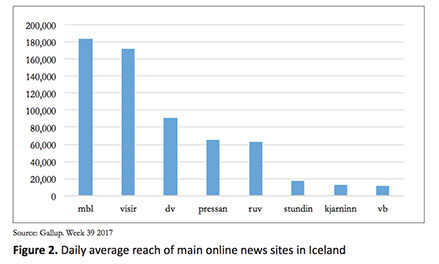A Nordic Nation Establishing its Unique Identity
Dominant Media Technology (ies)
Iceland seems to be following many of the same trends as the rest of the world as it relates to dominant media technologies. The financial crisis that Iceland underwent in 2008 affected media companies hard, and revenues declined by nearly 25% (Statistics Iceland 2018, a8). There are many news media companies in Iceland that are still struggling, however “it is difficult to discern the extent to which the difficulties [Iceland] is now facing are effects related to the crisis and the vulnerability of the small Icelandic market and what is linked to a worldwide trend brought about by the digital revolution” (Jóhannsdóttir and Ólafsson 16) (a4). This worldwide trend that they are talking about is familiar to us in the US: readership of newspapers going down and the use of technology that gives people access to immense amounts of information is going up (see chart of declining readership among Iceland’s top three newspapers).
Despite the fact that the Internet and the introduction of many new publication and media outlets to choose from gives Icelanders a large quantity of information and therefore many outlets to choose from (even though there are only about 332,000 of them), Icelanders

Chart is from article.
Knowledge Monopolies
continue to consume most of their media from “mainstream established news outlets” across all platforms (Jóhannsdóttir and Ólafsson 7). The most read online news sources are Árvakur’s mbl.is and visir. is, which formerly belonged to 365 Media, which is one of the major media knowledge monopolies in the country (more on this in the next section). Something important to note about Iceland’s Internet use is that Iceland is the only country in the world with 100% internet penetration (Internet World Stats 2017). For comparison, the average internet penetration in Europe is only about 80%.
In terms of technology to access this information, smartphones are used by 96% of 18-49 year-olds and “social media is extensively used, with Facebook being by far the most popular platform (Jóhannsdóttir and Ólafsson 8). These authors analyzed a Gallup survey of top social media usage in Iceland, which reported that 92% of Icelanders use Facebook, 62% use Snapchat, and 44% use Instagram. Collectively, Icelanders use social media more than other Nordic countries (Jóhannsdóttir and Ólafsson 8). See the interview section to learn more about highly used news media and social media.
There are three major media companies that dominate the flow of media: RÚV, 365 Media, and Árvakur. These are the companies who have the greatest number of journalists employed (70% of the 330 members of the Union of Icelandic Journalists work at these companies), largest audiences, and the highest revenue in the country (Ohlsson 2015 (a5); Guðmundsson 2013 (a3)). The Icelandic National Broadcasting Service, Ríkisútvarpið (shortened to RÚV), is s public service provider owned by the state, whose goal is to “inform, educate, and entertain” through radio, television, and online services (o43). RÚV’s mission is “to provide the public with reliable news service and culture and entertainment content of the highest quality.” They focus especially on the Icelandic language and Iceland’s unique history and heritage. According to their website, 95% percent of Icelanders use RÚV’s services every week and over 76% on a daily basis.
365 media is the largest private media company in Iceland. The free paper they produce, Fréttablaðið, is the most read newspaper in Iceland. The second largest private company is Árvakur. It publishes Morgunblaðið, Iceland’s oldest newspaper, with historical links to the conservative Independence Party. It has lost readership in physical form, but its online counter part, mbl.is, has been the most read online news site in Iceland since 1998 (Jóhannsdóttir and Ólafsson 4).
Additionally, there are online news sites with no links to traditional media which are highly read and used for people to get their daily news (see chart). There are local and regional newspapers produced, but they are not as widely read, as local media has historically been weak in comparison to the bigger players listed above, which makes sense given the small population size of Iceland (Jóhannsdóttir and Ólafsson 4). According to Jóhannsdóttir and Ólafsson, “traditional media and online-only media all make extensive use of social media” (4). As discussed above, the most commonly used social media site in Iceland is Facebook. Another popular alternative news site is Grapevine, discussed in many interviews. There are 12 domestic television stations and 19 radio stations, but also several other outlets for media.

Chart is from article.
Media plays a large role in Icelandic politics, especially traditional news media. According to Guðmundsson’s New Realities of Political Communications in Iceland and Norway (a3), television, radio, are newspapers are still very important, specifically in setting an agenda for what society at large will discuss on a daily basis. In interviews with the leading communication people of most of the national political parties in both Iceland and Norway, “both implicitly and explicitly they expressed the view that the traditional media, especially the large national media, dictated what was being discussed and controlled the definition of what is considered an important issue within a given day” (Guðmundsson 4).
The Icelandic media system also completely transformed during the last twenty years. Major shifts throughout the last decade in the political influence and ownership of the media changed who controlled the message and the dissemination of this message. Those developments and shifts lead to a new media market in Iceland beginning of the 21st century. According to the article, it has three major characteristics: first, the supply
of all forms of media is very high in Iceland, despite the fact local media is very weak (Harðarson 73). Second, “the commercialization of the media system has lead to convergence and concentration in private media ownership,” which we see in the fact that two of the three major media companies in Iceland are privately owned (Harðarson 73). The third characteristic is that private media are becoming more independent of political parties and their bias, and journalistic professionalism has increased in the new age, resulting in the media becoming their own entity rather than a tool of the party leadership. In the past there have been issues with conservative parties trying to influence private media, but on the whole, “political communication in Iceland is certainly no longer monopolized by the political parties” (Harðarson 74).
